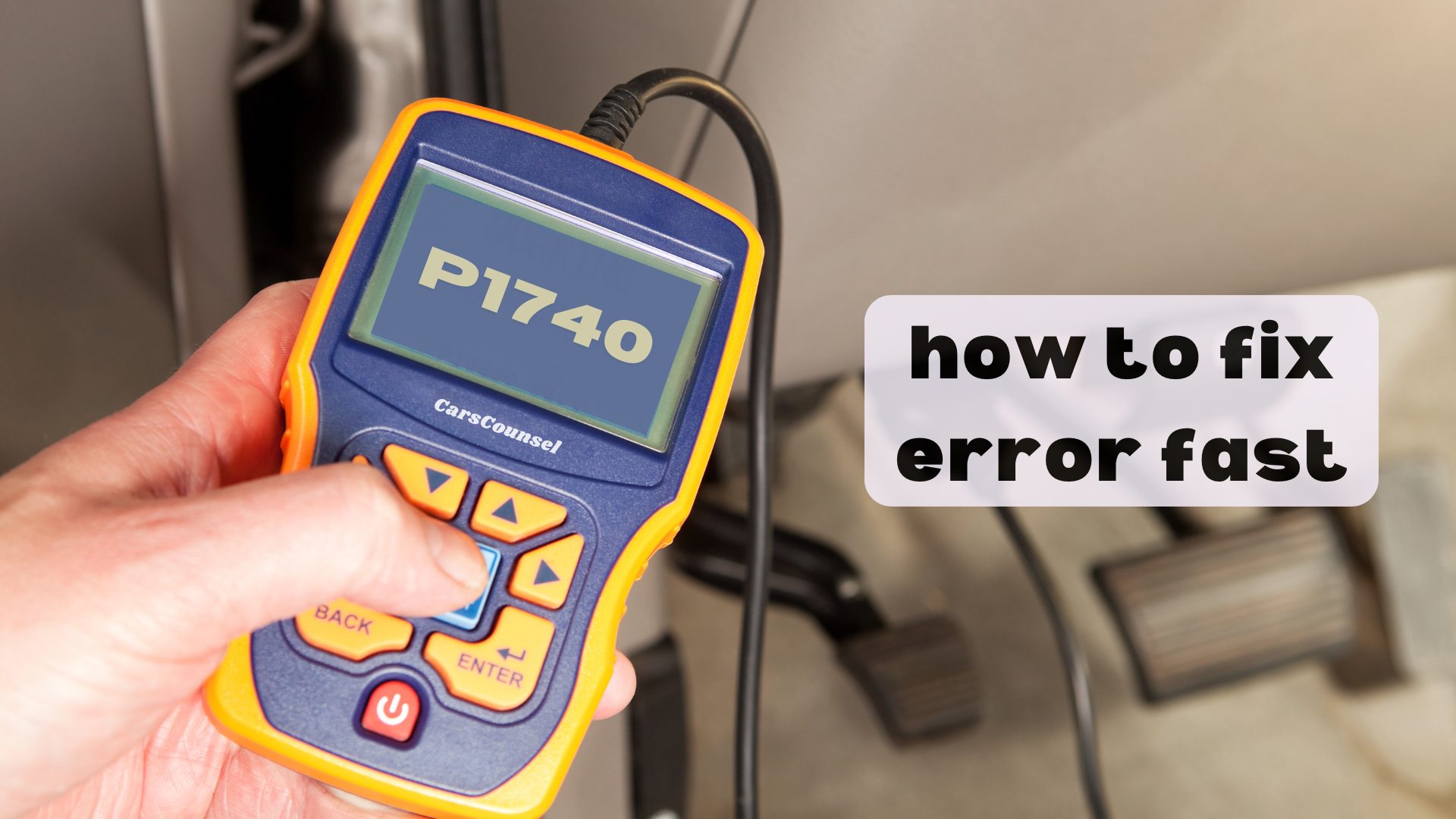When you see the P1740 code pop up, it’s essential to act quickly to prevent further damage to your vehicle.
Start by using an OBD-II scanner to find the trouble code, focusing on the torque converter clutch (TCC) solenoid.
While it might sound complicated, checking for damaged wiring and making sure your transmission fluid is clean and at the right level are easy steps you can take.
But what if the TCC solenoid is actually faulty?
In that case, you’ll need to drain the fluid and replace the solenoid, but there’s more to it than just that.

Quick Navigation
Key Takeaways
- Use an OBD-II scanner to read and confirm the P1740 code for accurate diagnosis.
- Check and refill transmission fluid if it’s low or looks dirty.
- Inspect and fix any damaged or corroded wiring connected to the TCC solenoid.
- Replace the faulty TCC solenoid to restore proper transmission function.
Understanding the P1740 Code
Understanding the P1740 code is important because it points to problems with the torque converter clutch (TCC) solenoid, which affects how your car’s transmission works.
The TCC solenoid helps control the torque converter, ensuring smooth power transfer from the engine to the transmission. If this solenoid isn’t working right, you might notice delayed or rough shifting, or overall poor transmission performance.
An OBD2 scanner usually diagnoses this code. It’s crucial to address the P1740 code promptly because ignoring it can lead to serious transmission issues, possibly needing expensive repairs.
Keeping an eye on your car’s behavior and fixing problems early ensures your transmission works well and lasts longer.
Common Causes of P1740
The P1740 code usually pops up because of a bad Torque Converter Clutch (TCC) solenoid, which messes with fluid control in the transmission. This issue throws off the fluid dynamics needed for the torque converter to work right.
Damaged or corroded wiring can also affect the solenoid, messing up the smooth flow of transmission fluid. Low transmission fluid levels make things worse, leading to solenoid problems.
Though it’s less common, a failed Transmission Control Module (TCM) can also cause the P1740 code. Over time, general wear and tear on the transmission and faulty sensors can add to this problem.
Keeping fluid levels in check and doing regular inspections can help avoid these issues.
Symptoms to Watch For
When you see a P1740 code, you might notice problems like the transmission slipping or shifting unpredictably. These issues point to problems with the TCC solenoid or other related parts. Such symptoms can mess with your car’s transmission, making the torque converter work less smoothly.
You might also see warning lights on your dashboard, hear strange noises from the transmission area, and use more fuel than usual. Another common problem is having trouble shifting gears, which means the transmission isn’t working properly.
Keep an eye on these symptoms. If you spot any of them, it’s crucial to fix them quickly to avoid more damage and keep your transmission in good shape.
Initial Diagnostic Steps
Initial Diagnostic Steps
To start diagnosing a P1740 code, you should first connect an OBD-II scanner to read the trouble code accurately. Use diagnostic tools to find any additional codes that might give you more context. Follow these troubleshooting steps:
- Check Wiring: Look for any damaged or corroded wires.
- Check Sensors: Make sure all sensors are working properly.
| Step | Action |
|---|---|
| Connect Scanner | Plug in the OBD-II scanner to get trouble codes |
| Check Wiring | Look for damaged or corroded wires |
| Check Sensors | Ensure sensors are working correctly |
| Visual Inspection | Look over the transmission for obvious problems |
Checking Transmission Fluid
Start by finding the transmission dipstick to check the fluid level and condition. Doing this right is key to making sure your transmission works well.
Follow these steps:
- Check Fluid Level: With the engine warmed up and running, pull out the dipstick, wipe it clean, put it back in, and then pull it out again to see the level.
- Look at Fluid Quality: Check the fluid color; it should be bright red or pink. Dark or burnt-smelling fluid means it’s contaminated.
- Add More if Needed: If the fluid is low, add the recommended transmission fluid until it reaches the correct level.
Inspecting for Leaks
Check the area around the transmission and underneath the vehicle for any signs of fluid leaks, as these can point to problems with seals, gaskets, or transmission lines.
Begin by thoroughly cleaning the transmission area to make spotting leaks easier. Look for fresh fluid spots on the ground or wet areas around the transmission. Pay special attention to the pan gasket, cooler lines, and axle seals.
You can also use a UV dye and black light to help identify leaks more accurately. If you find any leaks, fix or replace the faulty parts right away.
Make sure all fittings are tight and gaskets are properly in place. Fixing leaks quickly can prevent further transmission problems and help resolve the P1740 code more efficiently.
Visual Transmission Inspection
Start by looking over the entire transmission for any visible damage, wear, or rust. Pay special attention to:
- Cracks: These could mean serious internal problems.
- Fluid leaks: Check for wet spots or drips around seals and gaskets.
- Rust: Especially near electrical connections, since it can mess with performance.
Inspect all parts of the transmission, including the bellhousing, fluid pan, and lines.
Make sure there aren’t any loose or broken parts.
Use a flashlight to see into hard-to-reach areas.
A good visual check can help you catch issues early and avoid bigger transmission problems later on.
Replacing the TCC Solenoid
Replacing the TCC solenoid involves a few key steps to ensure a safe and effective repair. Start by disconnecting the battery and draining the transmission fluid.
Remove the transmission pan and filter to get to the TCC solenoid. Carefully unplug the old solenoid’s wiring and remove its mounting bolts.
Put in the new solenoid, making sure it’s secure. Reconnect the wiring, replace the transmission filter, and put the pan back on.
Refill the transmission with the right fluid and reconnect the battery.
This process will help restore the torque converter’s function, improving overall transmission performance.
It’s important to follow these steps carefully to avoid damaging any parts and to ensure a successful repair. Regular maintenance can help prevent future issues with the torque converter clutch.
Repairing Wiring Issues
To fix wiring problems related to the P1740 code, make sure to check and repair any damaged or corroded wires that could be affecting the TCC solenoid.
Start by looking at the wiring harness for any signs of wear or damage. Make sure all electrical connections are secure and clean.
Follow these steps:
- Check the Wiring Harness: Look for any frayed or broken wires that could be causing issues with the TCC solenoid.
- Inspect Electrical Connections: Ensure all plugs and connectors are properly connected and not corroded.
- Repair or Replace: Fix any damaged wires or corroded connectors to get everything working correctly.
Preventive Maintenance Tips
Regularly check and change your transmission fluid to keep it running smoothly and avoid problems like the P1740 code. Make sure the fluid is clean and at the right level. Dirty or low fluid can harm your transmission and cause issues with the solenoid.
Get your transmission inspected by a professional now and then to catch and fix small problems early. Change the transmission fluid filter as your car’s manufacturer recommends to keep things flowing well.
Also, try to avoid driving in ways that put a lot of stress on your transmission. By taking these simple steps, you can help your car last longer and avoid transmission issues.
More OBD-II Codes
Frequently Asked Questions
Can Driving With a P1740 Code Damage My Vehicle Further?
Driving with a P1740 code can make your transmission problems worse and put your safety at risk. Fix the issue right away to avoid more damage, save on expensive repairs, and make sure your car runs smoothly and safely.
How Much Does It Typically Cost to Repair a P1740 Code Issue?
Fixing a P1740 code usually costs between $200 and $600, depending on the parts and labor needed. You might also have to pay an extra $50 to $150 for the diagnostic check. The exact price can change based on your car’s make, model, and where you live.
Are There Any DIY Fixes for the P1740 Code?
You can start with a do-it-yourself diagnosis using an OBD-II scanner to confirm the P1740 code. Check the transmission fluid to make sure it’s at the right level and look over the wiring for any damage. These steps might help fix the problem.
How Long Does It Take to Fix a P1740 Code Problem?
Fixing a P1740 code usually takes a few hours, depending on what exactly is wrong. Figuring out and fixing problems with the solenoid or wiring can take different amounts of time, but overall, dealing with a P1740 code is usually pretty straightforward.
Is It Safe to Drive With a P1740 Code Until I Can Get It Fixed?
Driving with a P1740 code can be risky because it might lead to transmission problems. While you can keep an eye on the transmission fluid levels and avoid carrying heavy loads as a temporary fix, it’s important to get it professionally repaired as soon as possible to ensure your vehicle stays reliable.
Conclusion
Dealing with the P1740 code is like playing detective. Start by using an OBD-II scanner to diagnose the problem.
Then, check your fluid levels and inspect the wiring. If necessary, replace the TCC solenoid carefully.
Regular maintenance can help prevent future transmission issues. Think of your transmission as an orchestra—when it’s well-maintained, everything runs smoothly.
Keep your system in good shape and drive confidently.

